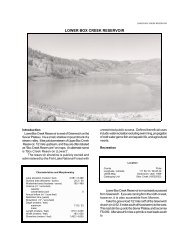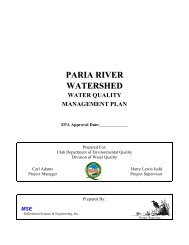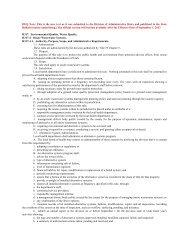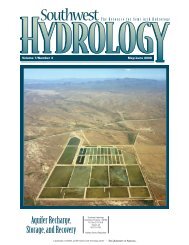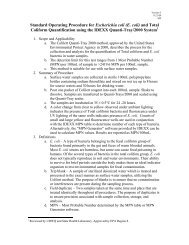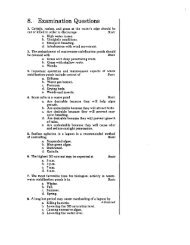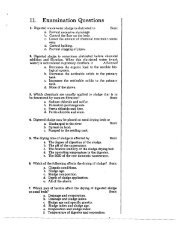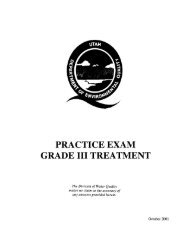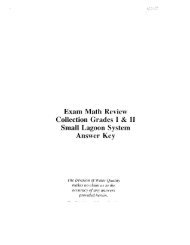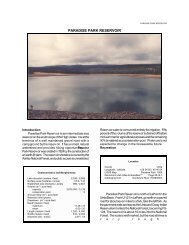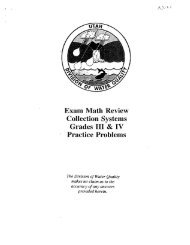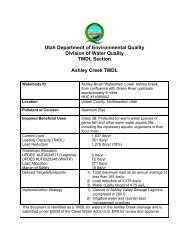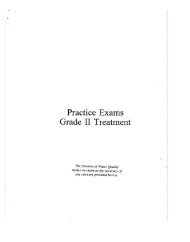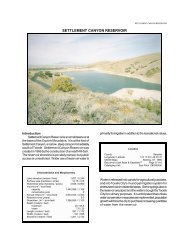Silver Creek - Division of Water Quality - Utah.gov
Silver Creek - Division of Water Quality - Utah.gov
Silver Creek - Division of Water Quality - Utah.gov
Create successful ePaper yourself
Turn your PDF publications into a flip-book with our unique Google optimized e-Paper software.
<strong>Silver</strong> <strong>Creek</strong> <strong>Water</strong>shed TMDL Final Report<br />
IV. Significant Sources<br />
(See Section 6.0 for details)<br />
Historical evidence indicates the source <strong>of</strong> metals <strong>of</strong> concern in this watershed are from historical<br />
mining activities in the Park City area. Most <strong>of</strong> the mining activity occurred within the upper<br />
watershed, primarily within Empire Canyon. Tailings from these mines were stored onsite or<br />
removed to another location, typically downstream. Significant source areas for zinc and<br />
cadmium are identified on Figure 22 and summarized in the following table:<br />
Description<br />
Upper <strong>Water</strong>shed Sources<br />
Prospector Square<br />
<strong>Silver</strong> Maple Claims<br />
Flood Plain Tails<br />
Richardson Flats<br />
Meadow Area<br />
Owner<br />
United Park City Mines<br />
Park City Municipal Corporation<br />
BLM<br />
United Park City Mines<br />
United Park City Mines<br />
Various Private Land Owners<br />
V. Technical Analysis<br />
(See Section 7.0 for details)<br />
Data are presented in Section 4.0 showing average concentrations and flows for bi-monthly<br />
periods at each “key” sampling location. Table 7 presents a summary <strong>of</strong> flows, concentrations<br />
and loads at key stations for each <strong>of</strong> these bi-monthly periods. Sections 9.0 and 10.0 provide the<br />
Best Management Practices (BMPs) that can be used to remedy the widespread nonpoint sources<br />
<strong>of</strong> metals in the <strong>Silver</strong> <strong>Creek</strong> <strong>Water</strong>shed. Literature values for the effectiveness <strong>of</strong> each BMP are<br />
provided in Table 14. Utilizing the removal efficiencies for each BMP, reductions in zinc and<br />
cadmium loading values are calculated along with anticipated stream concentrations after BMP<br />
implementation. Completion <strong>of</strong> scheduled BMPs is expected to achieve and maintain the TMDL<br />
endpoints for <strong>Silver</strong> <strong>Creek</strong>.<br />
VI. Margin <strong>of</strong> Safety & Seasonality<br />
(See Sections 4.0 & 5.0)<br />
There is significant variability in the existing flow and chemical data set for this TMDL which<br />
lends uncertainty to the loading analysis. Additionally, there is uncertainty in the actual degree<br />
<strong>of</strong> success that implementation <strong>of</strong> the BMPs identified to address nonpoint sources will achieve.<br />
Accordingly, the Margin <strong>of</strong> Safety to address these sources <strong>of</strong> uncertainty for this TMDL will<br />
include the following components:<br />
• An explicit margin <strong>of</strong> safety <strong>of</strong> 25% is utilized in the allocation calculations for the<br />
<strong>Silver</strong> <strong>Creek</strong> TMDL<br />
• Ongoing Monitoring Program will be implemented<br />
• Use <strong>of</strong> the maximum hardness <strong>of</strong> 400 mg/l in calculating the hardness adjusted <strong>Water</strong><br />
<strong>Quality</strong> Standards that are used as the endpoint for this TMDL (use <strong>of</strong> actual hardness<br />
would have resulted in higher values for the <strong>Water</strong> <strong>Quality</strong> Standards)<br />
Page 4




